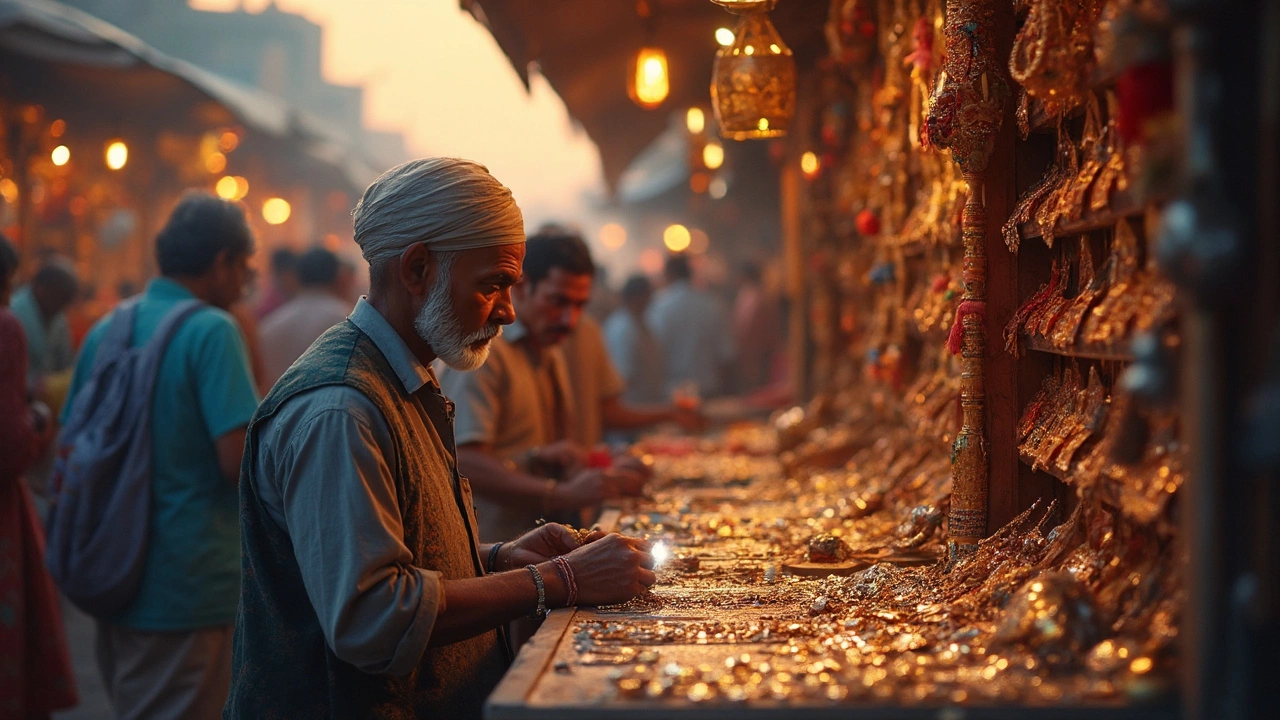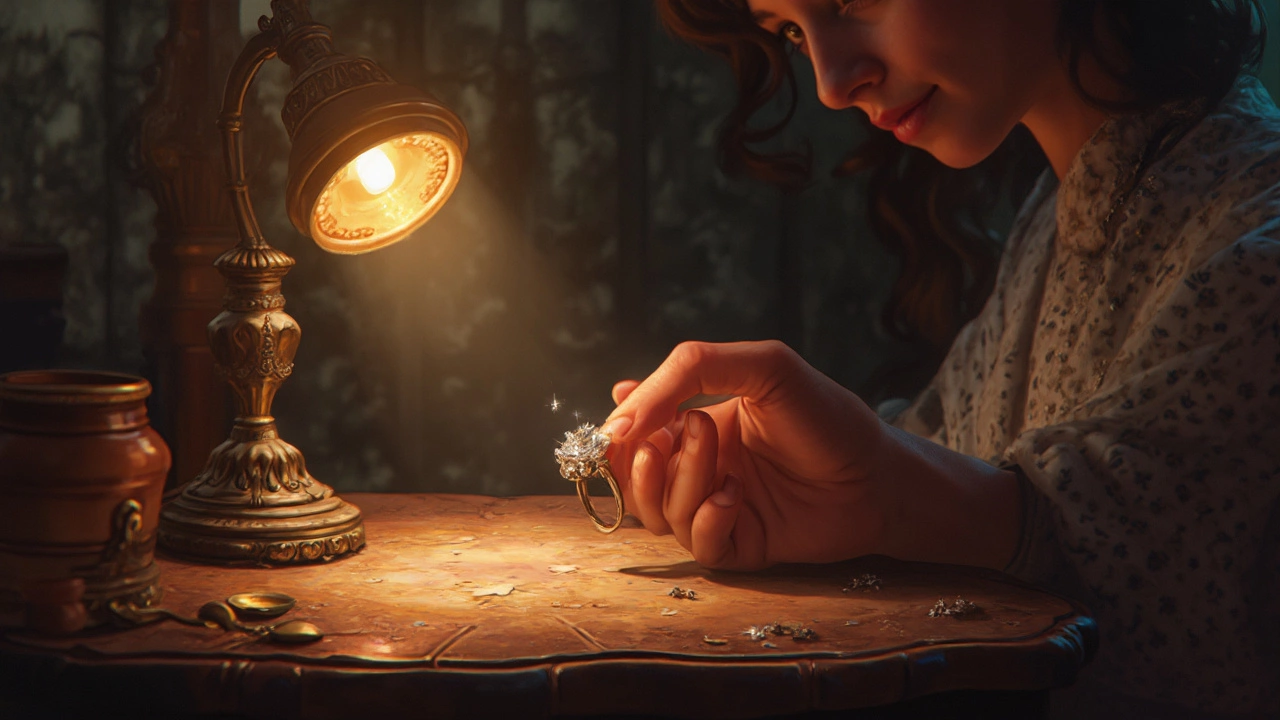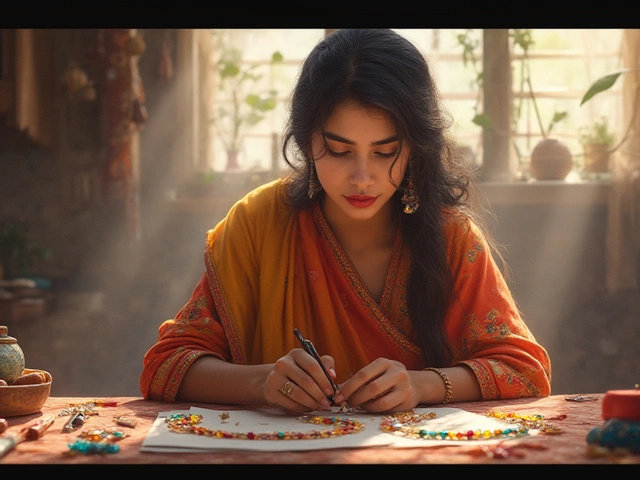You might think a flashlight is an unusual tool for testing diamond rings, but it's more practical than you'd imagine. Shining a beam of light through a diamond can reveal a lot about its authenticity. Real diamonds have this nifty trait: they refract light—a fancy way to say they bend it—in a way that gives them that classic sparkle you know and love.
When you shine your flashlight onto a suspected diamond, pay attention to the type of light it gives off. If it produces that brilliant prismatic effect, chances are, you're holding the real deal. But if it seems dull, the stone might be a cleverly disguised fake. It's a neat trick, especially when dealing with antique jewelry, where the quality of a diamond might not be immediately apparent.
- Flashlight Test Basics
- Visual Clues for Real Diamonds
- Examining Settings and Weight
- Tips for Antique Jewelry Lovers
Flashlight Test Basics
If you're curious about the simplest way to test a diamond ring, a flashlight test is an excellent start. The idea is straightforward: by using a flashlight, you utilize the unique properties of diamonds to tell if they're real or not.
Step-by-Step Guide
- Clean the Diamond: Before starting, clean your diamond ring to remove any dirt that might skew results.
- Dark Room: Find a dark room where the flashlight's light will be more noticeable against the diamond.
- Shine the Flashlight: Direct the flashlight beam straight at the diamond.
- Observe the Light: A genuine diamond will bend light in such a way that it creates a rainbow-like pattern inside the stone. If you see this, your diamond is likely real.
As Stuart Robertson, a recognized gem expert, says,
"A simple light test can quickly reveal insights into a diamond's real nature, providing everyday buyers a handy tool right in their pockets."
The refractive index of a diamond—how much it bends light—is about 2.42. This property helps it stand out from materials like cubic zirconia, which has a lower index and won't give off the same fiery colors when light passes through it.
While this method is a good start, it's not foolproof. Many fake stones can mimic a diamond's look under certain lights. It's wise to combine the flashlight test with other methods or consult a jeweler to be absolutely sure. Remember, fake diamonds are often very lightweight compared to the real ones.
Visual Clues for Real Diamonds
So you have a ring in front of you, and you're wondering if it's a real diamond. Apart from our trusty flashlight test, there are a bunch of visual clues that can help you out. Let's take a look!
Check the Reflections
If you observe the stone closely, real diamonds reflect light in shades of gray. If your diamond is showing rainbow colors inside, it might not be genuine, as cubic zirconia tends to sparkle more with colors.
Inspect the Edges
Real diamonds usually have sharp edges and a faceted cut. Counterfeit ones often sport rounder edges because they're a bit easier to manufacture that way. Keep an eye on those keen edges.
Look at the Underneath
Take a close peek through the setting. Real gems are often kept open at the back to let light do its magic, enhancing that sparkle. If the back is closed, be a little cautious and double-check everything.
Spotting the Material
A real diamond is mounted on either white gold or platinum because they can bear the weight. Fake ones often sit on cheaper metals due to cost-cutting. A thorough look for metal stamps can help; genuine gold or platinum will usually have identification marks.
If you're in the market, these little visual tricks can help steer clear of dupes. Oh, and watch out for wear and tear; genuine stones are incredibly hard and resist scratches more than imitation stones.

Examining Settings and Weight
One of the sneakiest tricks in spotting a real diamond ring from a fake one involves taking a good look at the settings and checking the weight of the piece. It's one of those steps that antique jewelry lovers swear by.
Check the Settings
Genuine diamond rings, especially high-quality ones, are usually set in equally high-quality metal settings like platinum or gold. So, start by checking the hallmark inside the band. A mark such as "10K," "14K," or "18K" indicates gold, while "PT" or "Plat" signifies platinum. If you spot a "CZ" stamp, watch out! It means cubic zirconia, a common diamond simulant.
Also, examine how the stone is set. Real diamonds are often held by prongs; they might be tiny, but they do a big job keeping the diamond secure. If you see glue around the stone, it’s a red flag.
Weigh and Compare
Weight is another big giveaway. In general, real diamonds are heavier than fake ones, like cubic zirconia. If you can, find a similar-sized cubic zirconia piece and compare them. You’ll notice that the real diamond will weigh more. If the ring seems suspiciously light, it’s worth getting a pro’s opinion.
Practice Makes Perfect
Knowing how to judge settings and weight isn't just useful; it’s an art. Practice makes perfect, and the more rings you examine, the sharper your skills will become. And remember, when in doubt, seek expert advice, especially with antique jewelry where authenticity adds a big chunk to value.
Tips for Antique Jewelry Lovers
Antique jewelry is like an untouched treasure chest filled with history and stories. If you're passionate about these timeless pieces, knowing how to spot real diamonds among them is crucial. Whether you're scouring flea markets or browsing online, these tips can help you make sure you're getting genuine gems.
Know Your Eras
Antique jewelry spans different periods, each with unique styles and manufacturing techniques. Victorian pieces often use rose-cut diamonds which are less sparkly compared to modern cuts. Edwardian jewelry features intricate designs with platinum settings. Recognizing these differences helps in authenticating the item and recognizing a real diamond.
Check the Settings
The way a diamond is set can tell a lot about its authenticity. In antique jewelry, look for signs of handmade craftsmanship, like slight imperfections or detailed work in the metal. Often, real diamonds in older pieces will be set with prongs or bezels that show age-appropriate wear—an excellent clue for determining if the piece is genuine.
Consider the Weight
Real diamonds weigh more than common fakes like cubic zirconia. When you're handling antique rings, feel if the weight corresponds to its size. A surprisingly light piece might indicate a non-diamond stone or a modern reproduction.
Use the Flashlight Test
As mentioned earlier, a simple flashlight can go a long way in spotting a real diamond. In the context of antique jewelry, this method helps verify stones without invasive testing. Just shine the flashlight and look for that telltale sparkle.
Collection Stats
If you’re serious about collecting, knowing the demographics can help. Here’s a quick look:
| Era | Popular Stone Cuts |
|---|---|
| Victorian | Rose-cut, Old Mine |
| Art Deco | Emerald-cut, Asscher |
| Edwardian | Round Brilliant, Old European |
Understanding these details can make antique jewelry hunting not just successful, but also incredibly rewarding. So next time you're browsing through a vintage market or an online auction, use these tips to ensure you're getting the real thing.



